Nature publishes a retraction of two controversial stem cell papers from earlier this year.
Date: 07.02.2014
Science Magazine brings news of a peer-reviewed analysis of purported Sasquatch hair samples. Genetic analysis reveals that bigfoot is probably not bigfoot.
In 2012, researchers at the University of Oxford in the United Kingdom and the Museum of Zoology in Lausanne, Switzerland, put out a call for hair samples thought to be from anomalous primates. They received 57 hairs from Bigfoot enthusiasts and museums around the world, including samples from Washington, Texas, Oregon, Russia, and India—a few as old as 50 years. Some “hairs” immediately turned out not to be hairs at all, but rather plant or glass fibers; others were too worn to study.
he researchers, led by Oxford geneticist Bryan Sykes, focused on the remaining 37 samples, isolating and cleaning a 2- to 4-centimeter segment of each hair, many of which have been extensively handled by people, contaminating them with foreign DNA. To identify the evolutionary source of each sample, the team determined the sequence of a gene—found inside the mitochondria of cells—that encodes the 12S RNA, which is often used for species identification. Unlike standard DNA, mitochondrial genes are passed only from mother to offspring.
Seven of the samples didn’t yield enough DNA for identification. Of the 30 that were sequenced, all matched the exact 12S RNA sequences for known species, the team reports online today in the Proceedings of the Royal Society B. Ten hairs belonged to various bear species; four were from horses; four were from wolves or dogs; one was a perfect match to a human hair; and the others came from cows, raccoons, deer, and even a porcupine. Two samples, from India and Bhutan, matched polar bear 12S RNA—a surprising finding that Sykes is following up on to determine whether some Himalayan bears are hybrid species with polar bears.
Read the full text of the study free at Proceedings of the Royal Society B.
